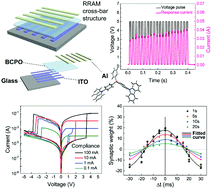当前位置:
X-MOL 学术
›
J. Mater. Chem. C
›
论文详情
Our official English website, www.x-mol.net, welcomes your feedback! (Note: you will need to create a separate account there.)
A bio-inspired electronic synapse using solution processable organic small molecule†
Journal of Materials Chemistry C ( IF 5.7 ) Pub Date : 2018-12-21 00:00:00 , DOI: 10.1039/c8tc05489d Jing-Yu Mao,Li Zhou,Yi Ren,Jia-Qin Yang,Chih-Li Chang,Heng-Chuan Lin,Ho-Hsiu Chou,Shi-Rui Zhang,Ye Zhou,Su-Ting Han
Journal of Materials Chemistry C ( IF 5.7 ) Pub Date : 2018-12-21 00:00:00 , DOI: 10.1039/c8tc05489d Jing-Yu Mao,Li Zhou,Yi Ren,Jia-Qin Yang,Chih-Li Chang,Heng-Chuan Lin,Ho-Hsiu Chou,Shi-Rui Zhang,Ye Zhou,Su-Ting Han

|
Mimicking biological synapses with resistive random switching memory (RRAM) can lay a concrete foundation for the future of artificial intelligence. RRAMs based on low-cost and solution-processed organic materials provide a competitive approach. Here, we report an artificial synaptic device with a solution-processed small molecule (bis-4-(N-carbazolyl)phenyl)phenylphosphine oxide (BCPO) based RRAM. The BCPO-based RRAM exhibits reproducible resistive switching behavior, a long retention time as well as good thermal tolerance with a sufficient on/off current ratio. In situ Kelvin probe force microscopy (KPFM), conductive atomic force microscopy (C-AFM) and density function theory (DFT) calculations demonstrate that both the redox state and the trap-filled space charge limited current (SCLC) determine the resistive switching of a BCPO-based RRAM. Furthermore, the fabricated device was employed to emulate a biological synapse in which several synaptic functions, including spike-rate-dependent plasticity (SRDP), a transition from short-term plasticity (STP) to long-term plasticity (LTP) and spike-time-dependent plasticity (STDP), were realized. To the best of our knowledge, this is the first successful demonstration of solution-processed small molecules in artificial synaptic devices. The BCPO layer is solution-processed at low temperature which is compatible with a flexible substrate and printable electronics. We believe this electronic synapse will have a wide range of applications in future neuromorphic computing.
中文翻译:

使用溶液可加工的有机小分子进行生物启发的电子突触†
用电阻随机开关存储器(RRAM)模仿生物突触可以为人工智能的未来奠定坚实的基础。基于低成本和溶液处理的有机材料的RRAM提供了一种有竞争力的方法。在这里,我们报告与基于溶液处理的小分子(双-4-(N-咔唑基)苯基)苯基膦氧化物(BCPO)的RRAM的人工突触设备。基于BCPO的RRAM具有可再现的电阻开关性能,较长的保留时间以及良好的耐热性以及足够的开/关电流比。原位开尔文探针力显微镜(KPFM),导电原子力显微镜(C-AFM)和密度函数理论(DFT)计算表明,氧化还原状态和陷阱填充的空间电荷限制电流(SCLC)都决定了BCPO的电阻切换基于RRAM。此外,制造的装置可用来模拟生物突触,其中一些突触功能包括尖峰速率依赖性可塑性(SRDP),从短期可塑性(STP)到长期可塑性(LTP)的转变以及尖峰-实现了与时间有关的可塑性(STDP)。据我们所知,这是在人工突触设备中溶液处理的小分子的首次成功演示。BCPO层在低温下进行固溶处理,与柔性基板和可印刷电子设备兼容。
更新日期:2018-12-21
中文翻译:

使用溶液可加工的有机小分子进行生物启发的电子突触†
用电阻随机开关存储器(RRAM)模仿生物突触可以为人工智能的未来奠定坚实的基础。基于低成本和溶液处理的有机材料的RRAM提供了一种有竞争力的方法。在这里,我们报告与基于溶液处理的小分子(双-4-(N-咔唑基)苯基)苯基膦氧化物(BCPO)的RRAM的人工突触设备。基于BCPO的RRAM具有可再现的电阻开关性能,较长的保留时间以及良好的耐热性以及足够的开/关电流比。原位开尔文探针力显微镜(KPFM),导电原子力显微镜(C-AFM)和密度函数理论(DFT)计算表明,氧化还原状态和陷阱填充的空间电荷限制电流(SCLC)都决定了BCPO的电阻切换基于RRAM。此外,制造的装置可用来模拟生物突触,其中一些突触功能包括尖峰速率依赖性可塑性(SRDP),从短期可塑性(STP)到长期可塑性(LTP)的转变以及尖峰-实现了与时间有关的可塑性(STDP)。据我们所知,这是在人工突触设备中溶液处理的小分子的首次成功演示。BCPO层在低温下进行固溶处理,与柔性基板和可印刷电子设备兼容。











































 京公网安备 11010802027423号
京公网安备 11010802027423号